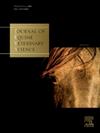Exposure of horses to biotoxins, phytoestrogens, and pesticides from different feed materials and supplementary feeds
IF 1.6
3区 农林科学
Q2 VETERINARY SCIENCES
引用次数: 0
Abstract
Background
The occurrence of biotoxins and chemical residues in marketed horse feeds has direct influences on horse health but has not been studied yet.
Aims/objectives
The study investigated the exposure and health implications of contaminants in various horse feedstuffs available on the European market.
Methods
A total of 108 feed samples representing diverse product categories such as hay, processed roughage products, grains, and various supplementary feeds were collected from different European countries and analyzed for contaminants, including mycotoxins, phytoestrogens, pesticides, and veterinary drug residues using liquid chromatography-tandem mass spectrometry (LC-MS/MS).
Results
Findings revealed that nearly all samples contained multiple fungal metabolites, with Fusarium toxins being the most prevalent. Processed roughage products (e.g., cobs, cubes, flakes and pellets) containing lucerne exhibited high concentrations of phytoestrogens and plant toxins compared to hay. The data also showed that supplementary feeds, particularly grain-based mueslis and mashes, were more prevalent sources of pesticide and veterinary drug residues than feed materials. Unusual substances in horse feed like colchicine and monensin, both highly toxic to horses, were also detected in roughly 10 to 20 % of the samples. However, our risk assesement suggests that the contamination of both compounds would not pose an acute health risk to horses.
Conclusions
The study reveals the complexity of biotoxins and chemical residues and their potential risks in marketed equine feeds and underscores the critical need for targeted regulations, routine testing to ensure equine health and welfare.

马接触来自不同饲料材料和补充饲料的生物毒素、植物雌激素和农药
市售马饲料中生物毒素和化学残留物的存在对马的健康有直接影响,但尚未有相关研究。目的/目标本研究调查了欧洲市场上各种马饲料中污染物的暴露和健康影响。方法采用液相色谱-串联质谱联用技术(LC-MS/MS)对来自欧洲不同国家的108份饲料样品(包括干草、加工粗饲料、谷物和各种补充饲料)中真菌毒素、植物雌激素、农药和兽药残留等污染物进行分析。结果发现,几乎所有样品均含有多种真菌代谢物,其中镰刀菌毒素最为普遍。与干草相比,含有苜蓿素的加工粗饲料(如玉米棒、立方体、薄片和颗粒)显示出高浓度的植物雌激素和植物毒素。数据还显示,与饲料相比,补充饲料,尤其是谷物杂粮和肉泥,是更普遍的农药和兽药残留来源。在大约10%到20%的样本中,还检测到马饲料中含有秋水仙碱和莫能菌素等不寻常物质,这两种物质对马都有剧毒。然而,我们的风险评估表明,这两种化合物的污染不会对马造成急性健康风险。结论:该研究揭示了市场上马饲料中生物毒素和化学残留的复杂性及其潜在风险,并强调了有针对性的法规和常规检测的必要性,以确保马的健康和福利。
本文章由计算机程序翻译,如有差异,请以英文原文为准。
求助全文
约1分钟内获得全文
求助全文
来源期刊

Journal of Equine Veterinary Science
农林科学-兽医学
CiteScore
2.70
自引率
7.70%
发文量
249
审稿时长
77 days
期刊介绍:
Journal of Equine Veterinary Science (JEVS) is an international publication designed for the practicing equine veterinarian, equine researcher, and other equine health care specialist. Published monthly, each issue of JEVS includes original research, reviews, case reports, short communications, and clinical techniques from leaders in the equine veterinary field, covering such topics as laminitis, reproduction, infectious disease, parasitology, behavior, podology, internal medicine, surgery and nutrition.
 求助内容:
求助内容: 应助结果提醒方式:
应助结果提醒方式:


